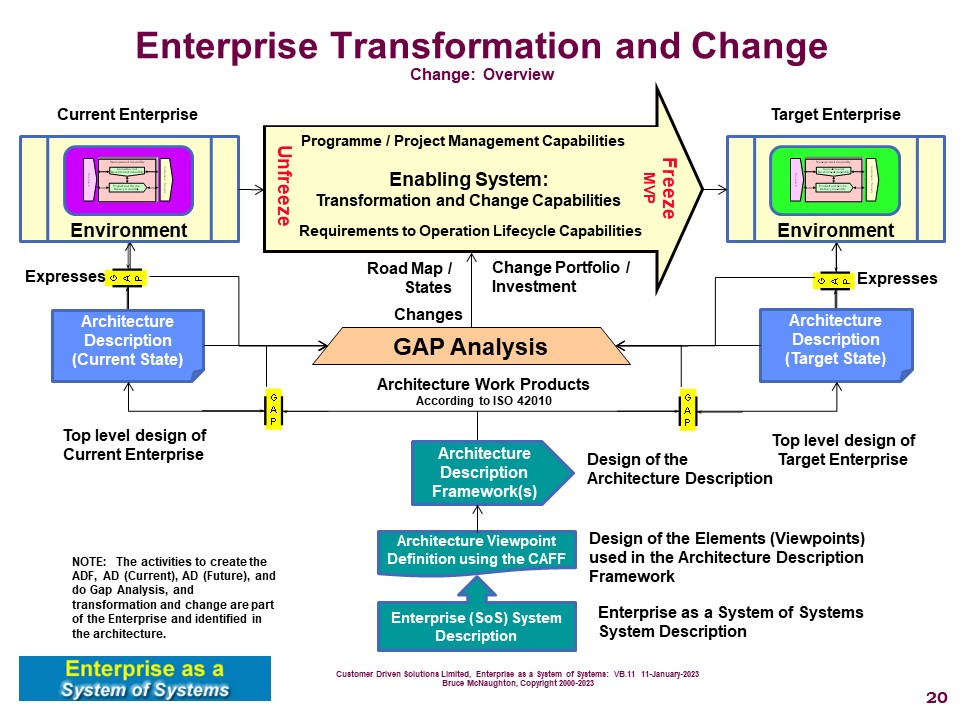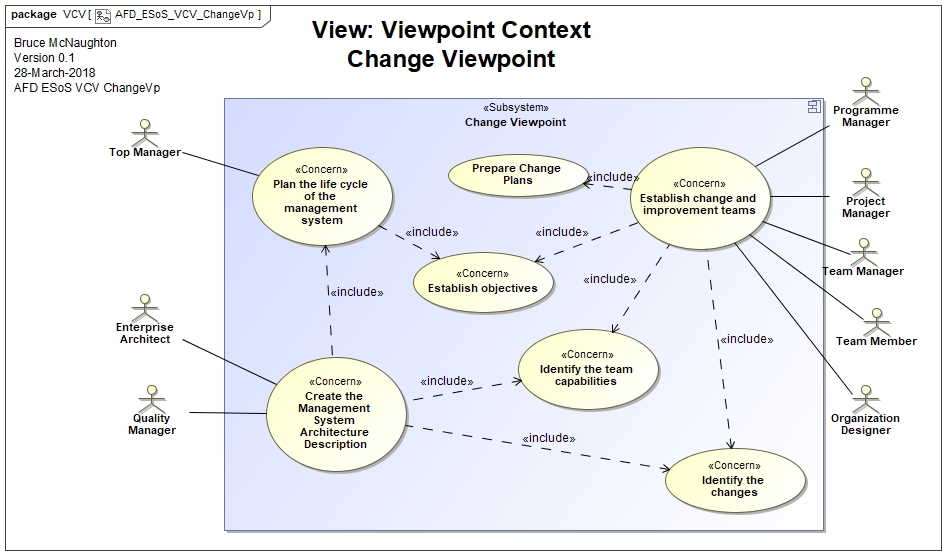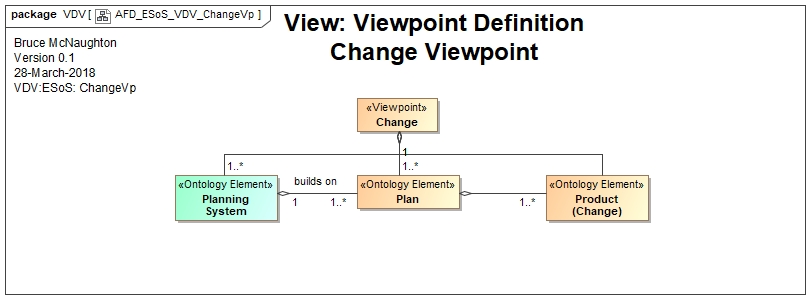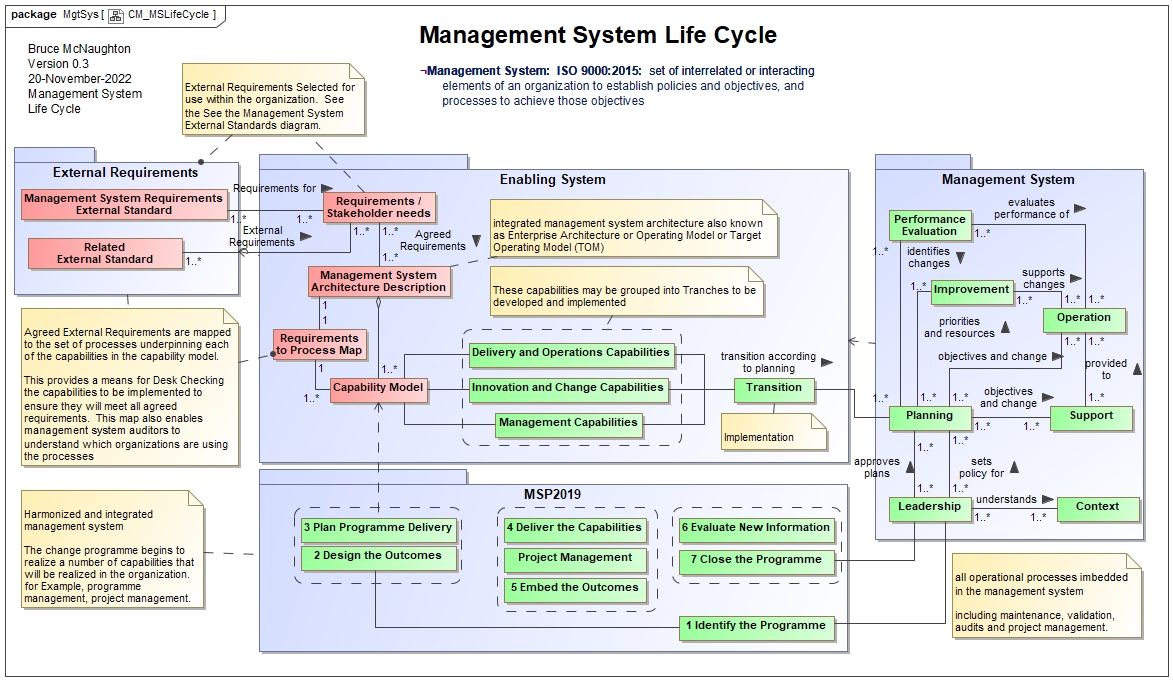Change Viewpoint
Description
The Change Viewpoint describes the approach to creating the Change View for an Architecture Description.
Every organization has a management system. This management system can be either:
-
ad hoc or not coherent (low maturity)
-
designed and capable of continual improvement or major improvement (high maturity)
These differences relate to management system maturity. Ad hoc management systems are not aligned and require extra work to change and achieve benefits. Some high performing organizations have established a culture of performance and improvement where change is valued and benefits are achieved as planned.
The most effective approach to management system maturity is to establish an Integrated Management System that can meet all relevant standards and regulations and can be implemented / replicated in a coherent way across the Enterprise (SoS).
PDF: System Description: Integrated Management System,
Every management system has an architecture. A future or target architecture description expresses the architecture of the management system at some future time. The change viewpoint describes the mechanism for moving from the current state of the management system to an intermediate state or the Target state of the enterprise or organization expressed by future architecture descriptions. The following picture shows the movement from the current state to the future or target state.

The activities to create a future architecture work closely with the activities to create the plans and strategies for the management system.
Gaps between the current AD and the intermediate state or target AD are identified. The GAPs represent investments that must be made to improve the way the management system works. These investments need to be prioritised and then delivered as part of the approved strategy and plan. The requirements are allocated to teams to make the changes to the management system. At the conclusion of the change, the parts that have been changed will now be described as part of the current architecture.
The Architecture is essentially the Top Level Design of the management system. Each architectural gap between 'how the management system works today' and 'How the management system wants to work' is translated into the live management system through a number of distinct steps: design, implement, integrate and operate. The steps create the Team capabilities necessary to carry out the new work.
The initial creation and implementation of the architecture description moves forward in small increments of creating the architecture elements and then implementing the elements to form a foundation for further development. This process is called an architecture bootstrap. This bootstrap process essentially creates management capabilities that create innovation and development capabilities and then create the delivery capabilities. These steps apply to a startup management system or an existing live management system that needs to understand and improve it's own architecture.
All change creates, improves or releases team capabilities and teams which may also include changes to Information System capabilities. Any change to the management system is a business change.
Where possible, the Target Architecture Description should be the 'idealized' architecture description or a 'realistic' alternative. (See Recreating the Corporation or Idealized Design)
Rationale
- Change is critical to the enterprise or organization remaining sustainable in the long term. This view demonstrates how the objectives and strategies that relate to changing capabilities and teams are translated into appropriate actions (manager actions, task teams, programmes or projects).
- Where necessary, suppliers in the supply chain are also identified to support the transformation and change.
- The change approaches are built into a well designed and implemented Integrated Management System. This supports:
- Continual improvement (regular and responsive)
- Major changes (planned and architected)
Stakeholders and their Concerns

Ontology Concepts and System Descriptions
System Descriptions: Management System, Team, Change and Transformation.

Models
Roadmap, Requirements, Risk
Product Breakdown Structure, Product Flow Diagram
Life cycle model (e.g. Process for improvement or transformation).
Improvement Model (e.g. process for Capability Improvement).
Steps to Create the View
- Initial Bootstrap of the organizational architecture.
- Use the planning process to identify gaps and strategies to close the gaps.
- Select the requirements and changes that deliver the highest value to the stakeholders.
- Monitor and track the changes (via the selected method to achieve the objective).
- Confirm that the changes have been completed and the benefits will be delivered
- Close when the benefits have been delivered.
NOTE: these steps can all be managed as a programme or project.
NOTE: A plan is a unique process. See ISO 9000 definition of project.
Correspondences
CR01: The Target Architecture Description becomes the Current Architecture Description once a change is complete.
CR02: Each system being changed will have its own system life cycle and architecture.
Examples
Sources
Notes
Reference the Transformation and Change section of the Eaasos.info website.
